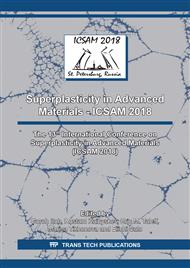p.397
p.403
p.407
p.413
p.419
p.424
p.430
p.437
p.443
Studies on Titanium Alloys for Aerospace Application
Abstract:
Since the development of the Ti54M titanium alloy in 2003, its application within the aerospace sector has gradually increased due to the combination of properties such as improved forgeability and machinability, low flow stress at elevated temperatures, and superplastic characteristics. However, for the successful exploitation of Ti54M a comprehensive understanding of its mechanical characteristics, microstructure stability, and superplastic behaviour is required. The superplastic forming of titanium alloys is characterised by high deformation at slow strain rates and high temperatures which influence the material microstructure, and in turn, determine the forming parameters. These mechanisms make the prediction of the material behaviour very challenging, limiting its application within the aerospace industry. Even though Ti54M has been commercially available for over 10 years, further studies of its mechanical and superplastic properties are still required with the aim of assessing its applicability within the aerospace industry as a replacement for other commercial titanium alloys. Therefore, in this work a study of the mechanical and superplastic properties of Ti54M, in comparison with other commercial titanium alloys used in the aerospace industry - i.e. Ti-6AL-4V, and Ti-6-2-4-2 - is presented. The final objective of this study, carried out at the Advanced Forming Research Centre (AFRC, University of Strathclyde, UK), is to obtain material data to calibrate and validate a model capable of estimating the behaviour and grain size evolution of titanium alloys at superplastic conditions.
Info:
Periodical:
Pages:
419-423
Citation:
Online since:
July 2018
Keywords:
Price:
Сopyright:
© 2018 Trans Tech Publications Ltd. All Rights Reserved
Share:
Citation:


